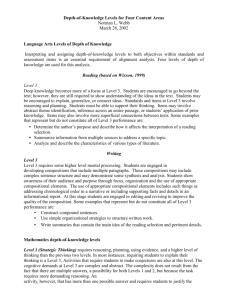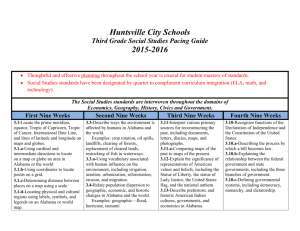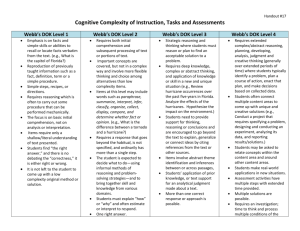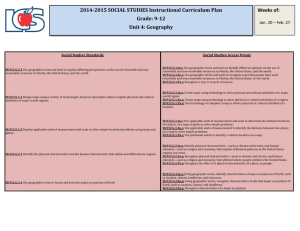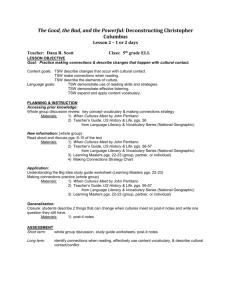3rd Grade Social Studies Instructional Planning
advertisement
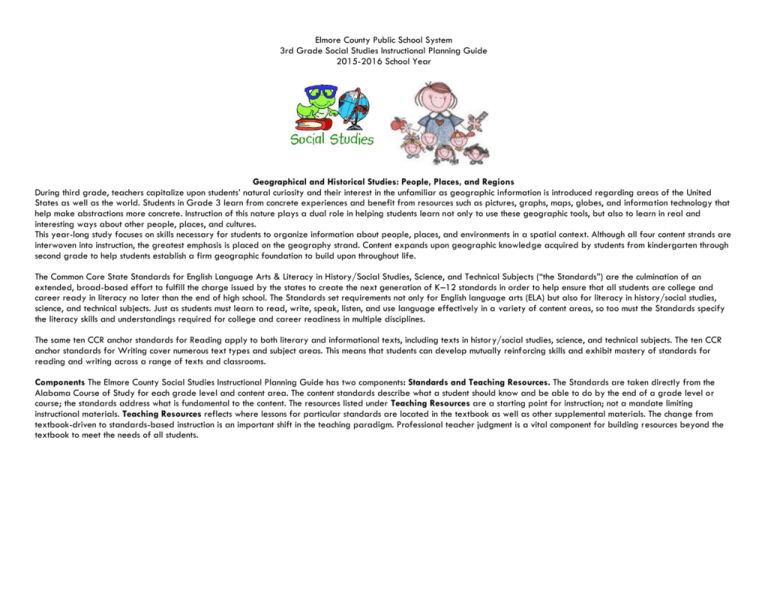
Elmore County Public School System 3rd Grade Social Studies Instructional Planning Guide 2015-2016 School Year Geographical and Historical Studies: People, Places, and Regions During third grade, teachers capitalize upon students’ natural curiosity and their interest in the unfamiliar as geographic information is introduced regarding areas of the United States as well as the world. Students in Grade 3 learn from concrete experiences and benefit from resources such as pictures, graphs, maps, globes, and information technology that help make abstractions more concrete. Instruction of this nature plays a dual role in helping students learn not only to use these geographic tools, but also to learn in real and interesting ways about other people, places, and cultures. This year-long study focuses on skills necessary for students to organize information about people, places, and environments in a spatial context. Although all four content strands are interwoven into instruction, the greatest emphasis is placed on the geography strand. Content expands upon geographic knowledge acquired by students from kindergarten through second grade to help students establish a firm geographic foundation to build upon throughout life. The Common Core State Standards for English Language Arts & Literacy in History/Social Studies, Science, and Technical Subjects (“the Standards”) are the culmination of an extended, broad-based effort to fulfill the charge issued by the states to create the next generation of K–12 standards in order to help ensure that all students are college and career ready in literacy no later than the end of high school. The Standards set requirements not only for English language arts (ELA) but also for literacy in history/social studies, science, and technical subjects. Just as students must learn to read, write, speak, listen, and use language effectively in a variety of content areas, so too must the Standards specify the literacy skills and understandings required for college and career readiness in multiple disciplines. The same ten CCR anchor standards for Reading apply to both literary and informational texts, including texts in history/social studies, science, and technical subjects. The ten CCR anchor standards for Writing cover numerous text types and subject areas. This means that students can develop mutually reinforcing skills and exhibit mastery of standards for reading and writing across a range of texts and classrooms. Components The Elmore County Social Studies Instructional Planning Guide has two components: Standards and Teaching Resources. The Standards are taken directly from the Alabama Course of Study for each grade level and content area. The content standards describe what a student should know and be able to do by the end of a grade level or course; the standards address what is fundamental to the content. The resources listed under Teaching Resources are a starting point for instruction; not a mandate limiting instructional materials. Teaching Resources reflects where lessons for particular standards are located in the textbook as well as other supplemental materials. The change from textbook-driven to standards-based instruction is an important shift in the teaching paradigm. Professional teacher judgment is a vital component for building resources beyond the textbook to meet the needs of all students. Social Studies 3rd Grade Instructional Planning Guide at a Glance Standard/Objectives 1. Locate the prime meridian, equator, Tropic of Capricorn, Tropic of Cancer, International Date Line, and lines of latitude and longitude on maps and globes. Using cardinal and intermediate directions to locate on a map or globe an area in Alabama or the world Using coordinates to locate points on a grid Determining distances between places on a map using a scale Locating physical and cultural regions using labels, symbols, and legends on an Alabama or world map Describing the use of geospatial technologies Examples: Global Positioning System (GPS), Geographic Information System (GIS) Interpreting information on thematic maps Examples: population, vegetation, climate, growing seasons, irrigation Using vocabulary associated with maps and globes, including megalopolis, landlocked, border, and elevation 2. Locate the continents on a map or globe. Using vocabulary associated with geographical features of Earth, including hill, plateau, valley, peninsula, isthmus, ice cap, and glacier Locating major mountain ranges, oceans, rivers, and lakes throughout the world. 3. Describe ways the environment is affected by humans in Alabama and the world. Examples: crop rotation, oil spills, landfills, clearing of forests, replacement of cleared lands, restocking of fish in waterways Using vocabulary associated with human influence on the environment, including irrigation, aeration, urbanization, reforestation, erosion, and migration 4. Relate population dispersion to geographic, economic, and historic changes in Alabama and the world. Examples: geographic - flood, hurricane, tsunami economic – crop failure historic – disease, war, migration Identifying human and physical criteria used to define regions and boundaries Examples: human – city boundaries, school districts lines physical – hemispheres, regions within continents or countries 5. Compare trading patterns between countries and regions. Differentiating between producers and consumers and imports and exports Differentiating between imports and exports Examples: imports – coffee, crude oil - exports – corn, wheat, automobiles Resources Note: Map and Globe Skills should be taught through-out the year. Map & Globe Skills TE pg. 32-33, 98-99, 110-111, 388-389 QuickReads, B-2, Maps, pgs. 10-23 S.S. Chapter 5, Community Environments, pgs. 142169 QuickReads, Level D-2, Geography and How We Live, p.10-18 S.S. Chapter 2, Kinds of Communities, p. 38-59 S.S. Chapter 3, People Move From Place to Place, p. 74-101 S.S. Chapter 2, Kinds of Communities, p. 38-59 S.S. Chapter 3, People Move From Place to Place, p. 74-101 QuickReads, D-1, Immigration to America, p. 10-23 S.S. Chapter 10, Making Goods, p. 334-339, 316343 S.S. Chap. 9, Making Choices, pgs. 288-315 Dates: Taught Tested Standard/Objectives 6. Identify conflicts within and between geographic areas involving use of land, economic competition for scarce resources, opposing political views, boundary disputes, and cultural differences Identifying examples of cooperation among governmental agencies within and between different geographic areas Examples: American Red Cross, Federal Emergency Management Agency (FEMA), World Health Organization (WHO) Locating areas of political conflict on maps and globes Explaining the role of the United Nations (UN) and the United States in resolving conflict within and between geographic areas 7. Describe the relationship between locations of resources and patterns of population distribution. Examples: presence of trees for building homes, availability of natural gas supply for heating, availability of water supply for drinking and for irrigating crops Locating major natural resources and deposits throughout the world on topographical maps Comparing present-day mechanization of labor with the historical use of human labor for harvesting natural resources. Examples: present-day practices of using machinery versus human labor to mine coal and harvest cotton and pecans Explaining the geographic impact of using petroleum, coal, nuclear power, and solar power as major energy sources in the twenty-first century 8. Identify geographic links of land regions, river systems, and interstate highways between Alabama and other states. Examples: Appalachian Mountains, Tennessee-Tombigbee Waterway, Interstate Highway 65 (I-65), Natchez Trace Parkway Locating the five geographic regions of Alabama Locating state and national parks on a map or globe. 9. Identify ways to prepare for natural disasters. Examples: constructing houses on stilts in flood-prone areas, buying earthquake and flood insurance, providing hurricane or tornado shelters, establishing emergency evacuation routes 10. Recognize functions of the Declaration of Independence and the Constitution of the United States. Describing the process by which a bill becomes a law. Explaining the relationship between the federal government and state governments, including the three branches of government Defining governmental systems, including democracy, monarchy, and dictatorship Resources S.S. Chapter 1, What are Communities? pgs. 10-35 Quick Reads, Level D-2, Natural Resources and the Economy, p.24-30 Note: All resources can be used at any time throughout this unit. Unit 6, Chapter 11, Rights and Responsibilities, pgs. 356-380 Unit 6, Chapter 12, Your Local Government, pgs. 382-408 QuickReads, C-2, Hurricanes, p. 10-23; Earthquakes, p. 24-37. Six Minutes Solutions, Intermediate, passages 401, 404, 416. QuickReads, D-1, Immigration to America, p. 10-23 Dates: Taught Tested Standard/Objectives 11. Interpret various primary sources for reconstructing the past, including documents, letters, diaries, maps, and photographs. Comparing maps of the past to maps of the present Resources Note: All resources can be used at any time throughout this unit. Unit 6, Chapter 11, Rights and Responsibilities, pgs. 356-380 Unit 6, Chapter 12, Your Local Government, pgs. 382-408 QuickReads, Level B-1, National Symbols, p. 1023; Being a Citizen, p. 24-37; Brave Americans, p. 38-51 QuickReads, Level C-1, Our National Government, p.80-88; American Heroes, p. 53-65. QuickReads, Level D-1, The Constitution of the United States, p. 24-37. Six Minute Solutions, Primary, passages 206-210 Six Minute Solutions, Inter-mediate, passage 207 12. Explain the significance of representations of American values and beliefs, including the Statue of Liberty, the Statue of Lady Justice, the United States flag, and the national anthem. Unit 6, Chapter 11, Rights and Responsibilities, pgs. 356-380 Unit 6, Chapter 12, Your Local Government, pgs. 382-408 QuickReads, Level B-1, National Symbols, p. 1023; Being a Citizen, p. 24-37; Brave Americans, p. 38-51 QuickReads, Level C-1, Our National Government, p.80-88; American Heroes, p. 53-65. QuickReads, Level D-1, The Constitution of the United States, p. 24-37. 13. Describe prehistoric and historic American Indian cultures, governments, and economics in Alabama. Example: prehistoric – Paleo-Indian, Archaic, Woodland, Mississippian historic – Choctaw, Chickasaw, Cherokee, Creek Identifying roles of archaeologists and paleontologists Six Minute Solutions, Primary, passages 206-210 Six Minute Solutions, Inter-mediate, passage 207 QuickReads, C-1, Dinosaurs, p. 13 & 17. Dates: Taught Tested Applying Depth-of-Knowledge (DOK) Levels in Social Studies Karin Hess, Center for Assessment According to Norman L. Webb (“Depth-of-Knowledge Levels for Four Content Areas,” March 28, 2002), interpreting and assigning depth-of-knowledge levels to both objectives within standards and assessment items is an essential requirement of alignment analysis. Four levels of Depth of Knowledge are used for this analysis. A general definition for each of the four (Webb) Depth-of-Knowledge levels is followed by Table 1, which provides further specification and examples for each of the DOK levels for social studies. Webb recommends that large-scale, on-demand assessments only assess Depth-of-Knowledge Levels 1, 2, and 3, due primarily to testing time constraints. Depth-of-Knowledge at Level 4 in social studies is best reserved for local assessment. Table 2 provides examples of DOK “ceilings” (the highest level of cognitive demand for large-scale assessment) using one state’s social studies grade level expectations. Descriptors of DOK Levels for Social Studies (based on Webb, Technical Issues in Large-Scale Assessment, report published by CCSSO, December 2002) Level 1 Recall of Information Level 1 asks students to recall facts, terms, concepts, trends, generalizations and theories or to recognize or identify specific information contained in graphics. This level generally requires students to identify, list, or define. The items at this level usually ask the student to recall who, what, when and where. Items that require students to “describe” and “explain” could be classified at Level 1 or 2 depending on what is to be described and explained. A Level 1 “describe or explain” would recall, recite or reproduce information. Items that require students to recognize or identify specific information contained in maps, charts, tables, graphs or drawings are generally level 1. Level 2 Basic Reasoning Level 2 includes the engagement of some mental processing beyond recalling or reproducing a response. This level generally requires students to contrast or compare people, places, events and concepts; convert information from one form to another; give an example; classify or sort items into meaningful categories; describe, interpret or explain issues and problems, patterns, reasons, cause and effect, significance or impact, relationships, points of view or processes. A Level 2 “describe or explain” would require students to go beyond a description or explanation of recalled information to describe or explain a result or “how” or “why.” Level 3 Complex Reasoning Level 3 requires reasoning, using evidence, and a higher level of thinking than the previous two levels. Students would go beyond explaining or describing “how and why” to justifying the “how and why” through application and evidence. The cognitive demands at Level 3 are more complex and more abstract than Levels 1 or 2. Items at Level 3 include drawing conclusions; citing evidence; applying concepts to new situations; using concepts to solve problems; analyzing similarities and differences in issues and problems; proposing and evaluating solutions to problems; recognizing and explaining misconceptions or making connections across time and place to explain a concept or big idea. Level 4 Extended Reasoning Level 4 requires the complex reasoning of Level 3 with the addition of planning, investigating, or developing that will most likely require an extended period of time. The extended time period is not a distinguishing factor if the required work is only repetitive and does not require applying significant conceptual understanding and higher-order thinking. At this level the cognitive demands should be high and the work should be very complex. Students should be required to connect and relate ideas and concepts within the content area or among content areas in order to be at this highest level. The distinguishing factor for Level 4 would be evidence through a task or product that the cognitive demands have been met. A Level 4 performance will require students to analyze and synthesize information from multiple sources, examine and explain alternative perspectives across a variety of sources and/or describe and illustrate how common themes and concepts are found across time and place. In some Level 4 performance students will make predictions with evidence as support, develop a logical argument, or plan and develop solutions to problems. Many on-demand assessment instruments will not include assessment activities that could be classified as Level 4. However, standards, goals, and objectives can be stated so as to expect students to perform thinking at this level. On-demand assessments that do include tasks, products, or extended responses would be classified as Level 4 when the task or response requires evidence that the cognitive requirements have been met. Source of Challenge Criterion for Social Studies The Source of Challenge criterion is only used to identify items where the major cognitive demand is inadvertently placed and is other than the targeted social studies content, concept, skill and application. Excessive reading demands, cultural bias, or specialized knowledge could be reasons for an item to have a source of challenge problem. Such item characteristics may cause some students to not answer an assessment item or answer an assessment item incorrectly even though they have the social studies content knowledge, understanding and skills being assessed. Items with an appropriate source of challenge level will differentiate between those students who have the social studies knowledge and understanding the assessment item intends to measure from those students who do not have this knowledge. Table 1: Sample Depth-of-Knowledge Level Descriptors for Social Studies (Based on Webb, Karin Hess, Center for Assessment/NCIEA, 2005 Level 1 a. b. c. d. e. Recall of Information Recall or recognition of: fact, term, concept, trend, generalization, event, or document Identify or describe features of places or people Identify key figures in a particular context meaning of words Describe or explain: who, what, where, when Identify specific information contained in maps, charts, tables, graphs, or drawings Level 2 Level 3 Basic Reasoning a. a. b. c. d. e. f. g. h. i. Describe cause-effect of particular events Describe or explain: how (relationships or results), why, points of view, processes, significance, or impact Identify patterns in events or behavior Categorize events or figures in history into meaningful groups Identify and summarize the major events, problem, solution, conflicts Distinguish between fact and opinion Organize information to show relationships Compare and contrast people, events, places, concepts Give examples and nonexamples to illustrate an idea/concept b. c. d. e. f. g. h. i. Complex Reasoning Explain, generalize, or connect ideas, using supporting evidence from a text/source Apply a concept in other contexts Make and support inferences about implied causes and effects Draw conclusion or form alternative conclusions Analyze how changes have affected people or places Use concepts to solve problems Analyze similarities and differences in issues or problems Propose and evaluate solutions Recognize and explain misconceptions related to concepts Level 4 Extended Reasoning a. Analyze and explain multiple perspectives or issues within or across time periods, events, or cultures b. Gather, analyze, organize, and synthesize information from multiple (print and non print) sources c. Make predictions with evidence as support d. Plan and develop solutions to problems e. Given a situation/problem, research, define, and describe the situation/problem and provide alternative solutions f. Describe, define, and illustrate common social, historical, economic, or geographical themes and how they interrelate

